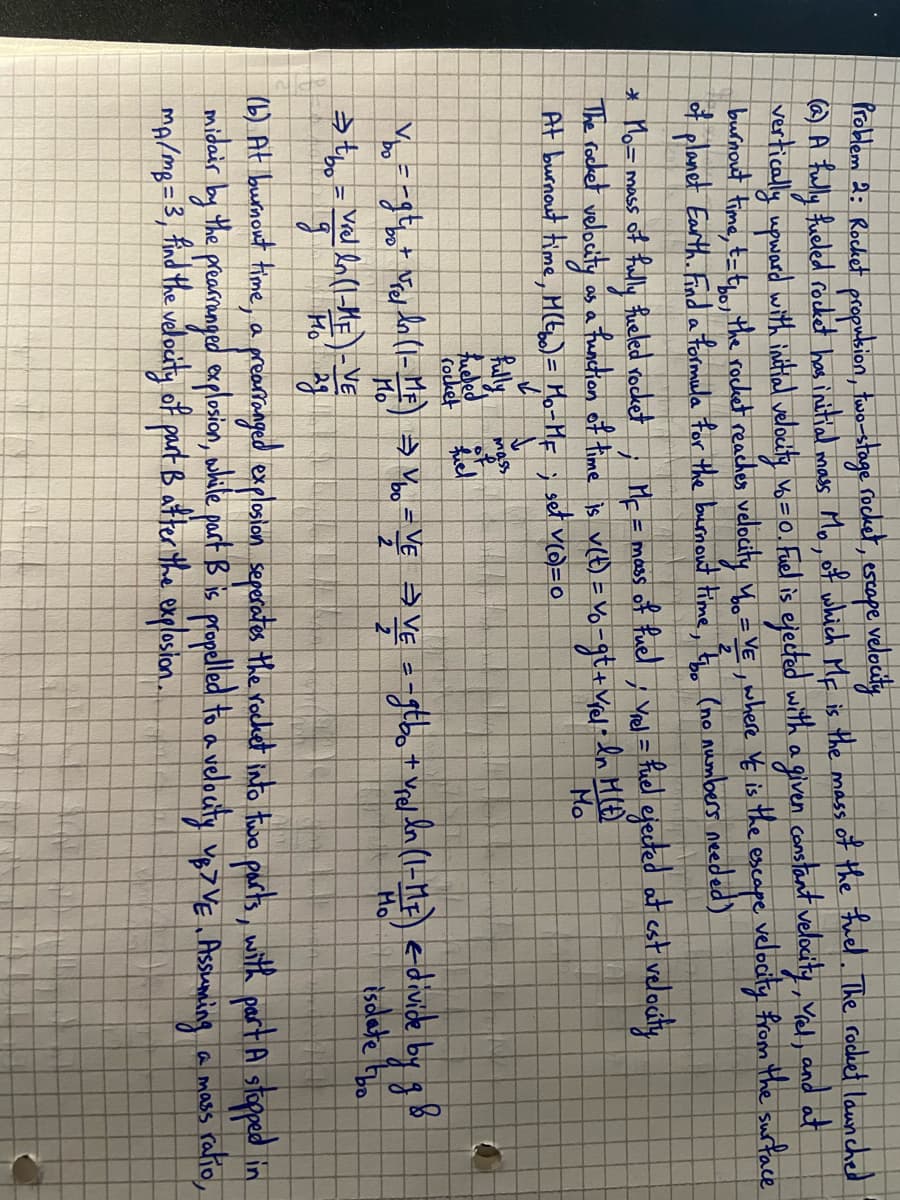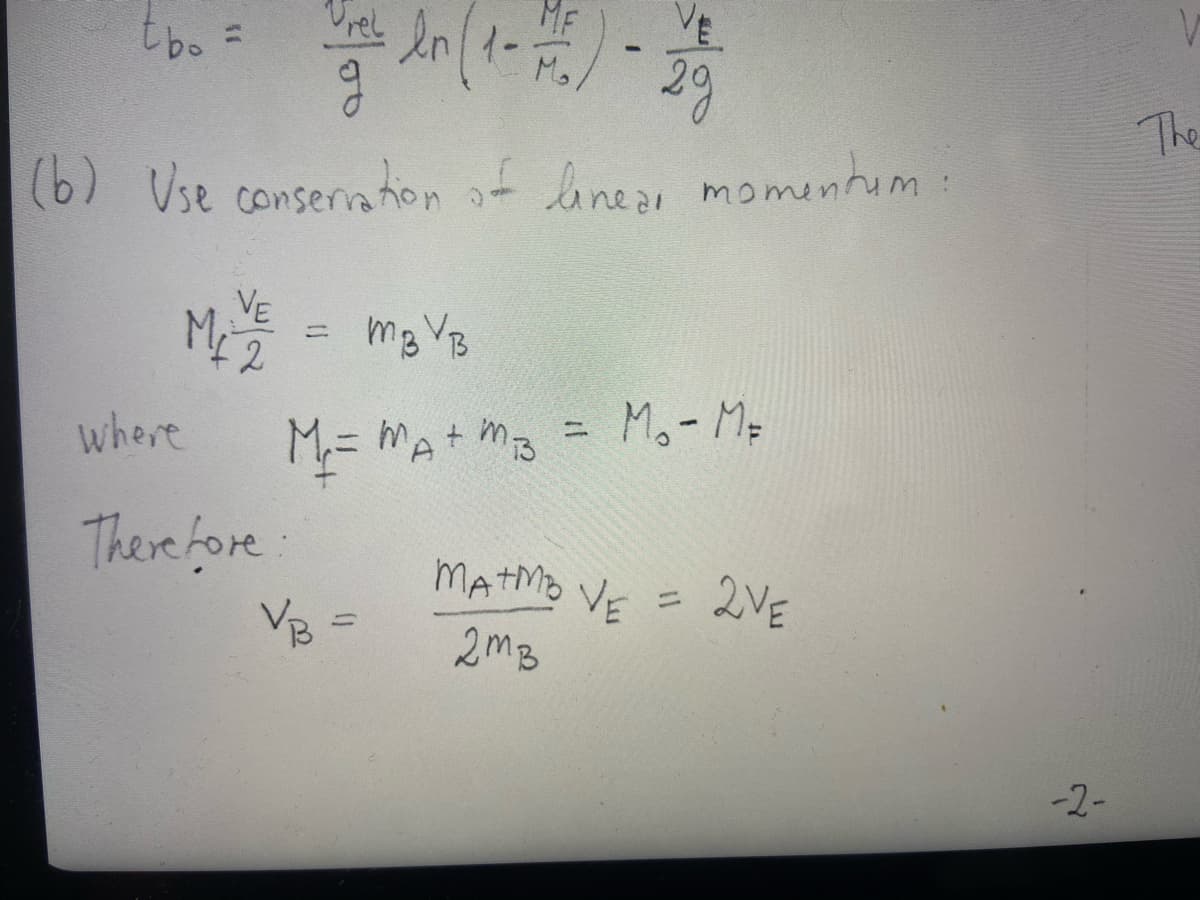University Physics Volume 1
18th Edition
ISBN:9781938168277
Author:William Moebs, Samuel J. Ling, Jeff Sanny
Publisher:William Moebs, Samuel J. Ling, Jeff Sanny
Chapter9: Linear Momentum And Collisions
Section: Chapter Questions
Problem 103AP: Three skydivers are plummeting earthward. They are initially holding onto each other, but then push...
Related questions
Question
Can you explain part b
I attached the solution I don’t understand what they are doing with the formula of conservation of linear momentum why are there two types of Mf and MF

Transcribed Image Text:Problem 2: Rocket propulsion, two-stage rocket, escape velocity
with
(a) A fully fueled rocket has initial mass Mo, of which Mr is the mass of the fuel. The rocket launched
a given constant velocity, Viel, and at
vertically upward with initial velocity vo = 0. fuel is ejected
burnout time, t-too, the rocket reaches velocity 4₂. = VE, where VE is the escape
of planet Earth. Find a formula for the burnout time, too (no numbers needed)
velocity from the surface
bo
2
bo
* Mo= mass of fully fueled rocket Mr = mass
of fuel
The rocket velocity
a function of time is v(t) = vo - gt + vrel-
as a
At burnout time, M(tbo) = M₁-MF; set V(0) = 0
fully
fueled
rocket
; Vrel = fuel ejected at est velocity
ln MCĐ
Mo
mass
of
fuel
=
vallo (1-1)-9
но зд
g
b
Yoo = -gt bot vrel In (1- ME) ⇒ Vbo = VE ⇒ VE = - gtbo + vurel In (1-MF) <-divide by g
bo
2
2
isolate bo
(6) At burnout time, a prearranged explosion seperates the rocket into two parts, with part A stopped in
midair by the prearranged explosion, while part B is propelled to a velocity VB7VE. Assuming
MA/MB = 3, find the velocity of part B after the explosion.
a mass ratio,

Transcribed Image Text:VE
29
(b) Use conservation of lineal momentum:
tbo
VE
ME 2
where
Therefore
mBVB
M₂ = MA+MB3
VB
-
= M₁-M=
MATMA VE = 2VE
2MB
-2-
The
Expert Solution
This question has been solved!
Explore an expertly crafted, step-by-step solution for a thorough understanding of key concepts.
Step by step
Solved in 3 steps

Knowledge Booster
Learn more about
Need a deep-dive on the concept behind this application? Look no further. Learn more about this topic, physics and related others by exploring similar questions and additional content below.Recommended textbooks for you

University Physics Volume 1
Physics
ISBN:
9781938168277
Author:
William Moebs, Samuel J. Ling, Jeff Sanny
Publisher:
OpenStax - Rice University

Glencoe Physics: Principles and Problems, Student…
Physics
ISBN:
9780078807213
Author:
Paul W. Zitzewitz
Publisher:
Glencoe/McGraw-Hill

Classical Dynamics of Particles and Systems
Physics
ISBN:
9780534408961
Author:
Stephen T. Thornton, Jerry B. Marion
Publisher:
Cengage Learning

University Physics Volume 1
Physics
ISBN:
9781938168277
Author:
William Moebs, Samuel J. Ling, Jeff Sanny
Publisher:
OpenStax - Rice University

Glencoe Physics: Principles and Problems, Student…
Physics
ISBN:
9780078807213
Author:
Paul W. Zitzewitz
Publisher:
Glencoe/McGraw-Hill

Classical Dynamics of Particles and Systems
Physics
ISBN:
9780534408961
Author:
Stephen T. Thornton, Jerry B. Marion
Publisher:
Cengage Learning